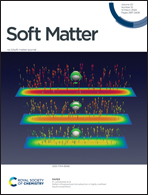Directional actuation and phase transition-like behavior in anisotropic networks of responsive microfibers†
Abstract
Two-dimensional shape-morphing networks are common in biological systems and have garnered attention due to their nontrivial physical properties that emanate from their cellular nature. Here, we present the fabrication and characterization of anisotropic shape-morphing networks composed of thermoresponsive polymeric microfibers. By strategically positioning fibers with varying responses, we construct networks that exhibit directional actuation. The individual segments within the network display either a linear extension or buckling upon swelling, depending on their radius and length, and the transition between these morphing behaviors resembles Landau's second-order phase transition. The microscale variations in morphing behaviors are translated into observable macroscopic effects, wherein regions undergoing linear expansion retain their shape upon swelling, whereas buckled regions demonstrate negative compressibility and shrink. Manipulating the macroscale morphing by adjusting the properties of the fibrous microsegments offers a means to modulate and program morphing with mesoscale precision and unlocks novel opportunities for developing programmable microscale soft robotics and actuators.



 Please wait while we load your content...
Please wait while we load your content...